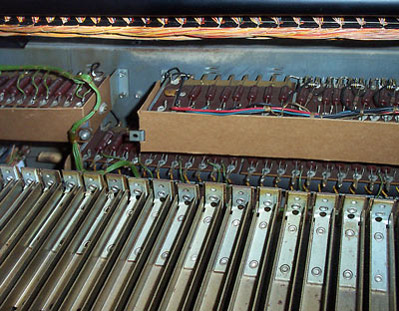X 66
North Suburban HAMMOND ORGAN Service

Figure 14, X66 key channels.
Before we continue on with more tech talk about how the various sections of the Hammond X66 work, let's take a break and have a look inside an actual X66 to see what it looks like inside that fancy, futuristic console. We'll start with figure fourteen which shows the key channels of the upper manual with the upper control panel section raised out of the way.
Traditional Hammonds are very reliable. But, as many Hammond technicians will tell you, they are a bitch to work on as far as gaining access to keyboard internals. In the X66, this has been somewhat corrected although certain things are still very hard to work on, but accessibility to key contacts and other sections is, depending on what needs attention, significantly to at least slightly easier than it is in traditional Hammonds. For one thing, you can remove the top of an X66 console. On a traditional C3 or B3, the top is extremely well glued to the rest of the console woodwork, so essentially the console is a one-piece structure; you run a very real risk of damaging the console woodwork at least slightly if you try to remove the top of a B3 or a C3. But removal of the top of an X66 console requires only the removal of four screws. With the console top removed, you gain access to the control panel section, which is on hinges and swings up out of the way to reveal what we see above, the channels of the upper keyboard.
Like all Hammonds, you'll note that the keyboard structural members are all steel. This makes them much more dimensionally stable than more traditional keyboards that are made of wood and are subject to slight seasonal dimensional changes. As a rule, once the people in the Hammond factory got through adjusting a Hammond keyboard, it should remain correctly adjusted for years. Eventually the key combs will wear, and the up- and downstop felts will get somewhat compressed and hardened making the keyboard slightly noisy, but even then, the keyboard still remains accurate, comfortable and easily playable.
There are three different scanner type vibrato effects in an X66. Review the Hammond vibrato in the Hammond article if necessary. The operating principle of these three vibrato systems in the X66 is essentially the same. But the X66 vibrato systems are different in slight but important ways. When we get into the X66 animation system, which is what Hammond calls the complete vibrato system, we'll look at these differences in detail, because they are significant contributors to both the realistic and significantly improved tonality of the X66 as compared to other tonewheel Hammonds that also use the unique Hammond scanner type vibrato system. There is also a fourth vibrato system that works in a similar manner to the vibrato of the Wurlitzer 4600 series instruments, but the implementation of that vibrato is carried out quite differently.
Each vibrato system in the X66 is designed for a particular kind of vibrato or vibrato-related effect. This is much like the multiple tremulants of better pipe organs where different ranks of pipes have different tremulants and where the effect of the tremulant on the resulting tones from the pipes is also different depending on how the pipes are designed during manufacture.
Eventually an article on real pipe organs may be useful in this website but for the moment, we'll concentrate on those instruments which we generally use at our meetings.
Previous Page Page 11. Next page